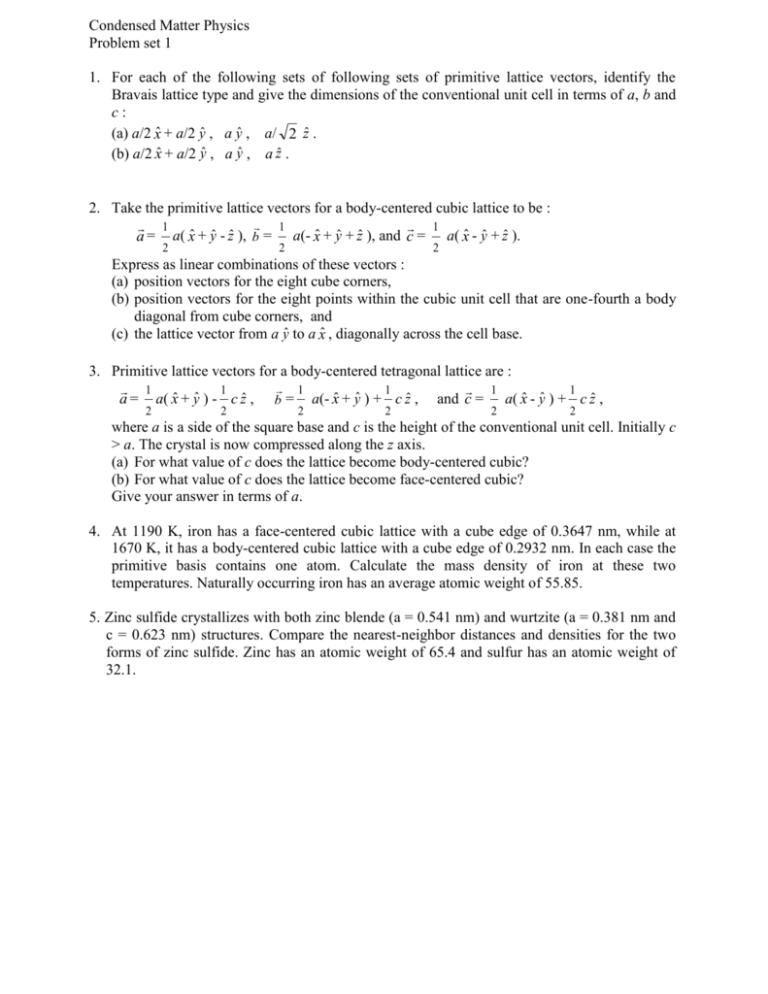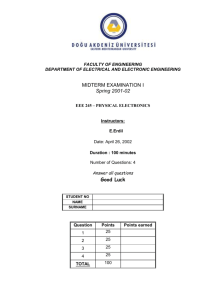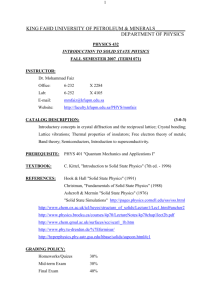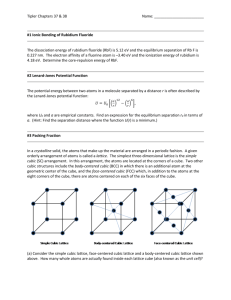Problem sets
advertisement

Condensed Matter Physics Problem set 1 1. For each of the following sets of following sets of primitive lattice vectors, identify the Bravais lattice type and give the dimensions of the conventional unit cell in terms of a, b and c: (a) a/2 x̂ + a/2 ŷ , a ŷ , a/ 2 ẑ . (b) a/2 x̂ + a/2 ŷ , a ŷ , a ẑ . 2. Take the primitive lattice vectors for a body-centered cubic lattice to be : 1 1 1 a = a( x̂ + ŷ - ẑ ), b = a(- x̂ + ŷ + ẑ ), and c = a( x̂ - ŷ + ẑ ). 2 2 2 Express as linear combinations of these vectors : (a) position vectors for the eight cube corners, (b) position vectors for the eight points within the cubic unit cell that are one-fourth a body diagonal from cube corners, and (c) the lattice vector from a ŷ to a x̂ , diagonally across the cell base. 3. Primitive lattice vectors for a body-centered tetragonal lattice are : 1 1 1 1 1 1 a = a( x̂ + ŷ ) - c ẑ , b = a(- x̂ + ŷ ) + c ẑ , and c = a( x̂ - ŷ ) + c ẑ , 2 2 2 2 2 2 where a is a side of the square base and c is the height of the conventional unit cell. Initially c > a. The crystal is now compressed along the z axis. (a) For what value of c does the lattice become body-centered cubic? (b) For what value of c does the lattice become face-centered cubic? Give your answer in terms of a. 4. At 1190 K, iron has a face-centered cubic lattice with a cube edge of 0.3647 nm, while at 1670 K, it has a body-centered cubic lattice with a cube edge of 0.2932 nm. In each case the primitive basis contains one atom. Calculate the mass density of iron at these two temperatures. Naturally occurring iron has an average atomic weight of 55.85. 5. Zinc sulfide crystallizes with both zinc blende (a = 0.541 nm) and wurtzite (a = 0.381 nm and c = 0.623 nm) structures. Compare the nearest-neighbor distances and densities for the two forms of zinc sulfide. Zinc has an atomic weight of 65.4 and sulfur has an atomic weight of 32.1. Condensed Matter Physics : Problem set 2 1. Show that the volume of the first Brillouin zone is (2)3/, where is the volume of a primitive unit cell. Note : ( c a ) ( a b ) = [ c ( a b )] a . 2. For a linear crystal with N scattering centers at every lattice point r = n a, where n is an N 1 integer, the scattered radiation amplitude is proportional to A = exp(-ina s ) = n 0 [1exp(iN a s )]/[1exp(i a s )]. sin 2 ( Na s / 2) 2 (a) The scattered radiation intensity is proportional to A = AA* = . sin 2 (a s / 2) (b) A diffraction maximum appears when a s = 2h, where h is an integer. Show that when a s is changed slightly to 2h + , with = 2/N, the first zero in sin (N a s /2) is resulted. Furthermore, the width of the diffraction maximum is proportional to 1/N, and can be extremely narrow for macroscopic values of N. [Note that the same result holds true for a 3-dimensional crystal]. 3. For diamond : (a) Find the structure factor F of a basis associated with a conventional unit cell. (b) Find the zeros of F and shows that the allowed reflections of diamond structure satisfy h + k + l = 4n, where all indices are even and n is any integer, or else all indices are odd. (c) Compare the results with the experimental data shown in the figure. (111) Counts (220) (311) (400) 20o 30o 45o 60o 75o 4. Consider a chain of atoms ABAB…..AB, with an A-B bond length of a/2. The form factors are fA and fB for atoms A and B, respectively. The incident beam of X-ray is perpendicular to the line of atoms. (a) Show that the interference condition is n = a cos , where is the angle between the diffracted beam and the line of atoms. (b) Show that the intensity of the diffracted beam is proportional to fA - fB2 for n odd, and to fA + fB2 for n even. (c) Explain what happens if fA = fB. 5. A tetrahedral lattice has fundamental lattice vectors a =a x̂ , b =a ŷ and c =c ẑ . The propagation vector for an incident x-ray beam (with wavelength ) is in the x-y plane and makes with the angle with the x-axis. (a) Show that for elastic scattering associated with the (hkl) planes : a h cos + k sin = [(h2+k2)/a2 + l2/c2]. 2 (b) Show that no peaks with indices of the form (00l) are produced. (c) If = 0.154 nm, a = 0.473 nm and c = 0.571 nm, find for the diffraction from (100), (101) and (111) planes. (d) Find scattering angle for each of the peak of part (c). Condensed Matter Physics Problem set 3 1. For a planar square lattice of rows and columns of identical atoms, ulm is the displacement normal to the plane of the lattice of the atoms in the lth column and mth row. The mass of each atom is m, and is the force constant for nearest neighbor atoms. (a) Show that the equation of motion is : m d 2 u lm dt2 = [(ul+1,m + ul1,m 2 ulm) + (ul,m+1 + ul,m1 2 ulm). (b) Assume solutions of the form ulm = A exp i(lqxa + mqya t). Show that the dispersion relation is : 2m = 2 (2 cos qxa cos qya). (c) Show that the region of reciprocal lattice space for which independent solutions exist may be taken as a square of side 2/a. This is 1st Brillouin zone of the lattice. (d) Sketch versus q for q = qx with qy = 0, (e) Sketch versus q for qx = qy. (f) For qa << 1, show that = (a2/m)1/2 (qx2 + qy2)1/2 = (a2/m)1/2 q. (g) In the limit of point (e), find the sound speed and show that it is constant. l,m+1 a l1,m l,m l+1,m a l,m1 2. In a monatomic linear crystal, the displacements of the nth ion core and the center of mass of its outer electrons are uin = A exp i(qna t) and uen = B exp i(qna t), where a is the lattice constant. (a) Verify that the equations of motion of uin and uen are : M d 2 u in dt2 = 2 (uen uin), d 2 u en = 2 (uin uen) + 1 (uen1 + uen+1 2 uen), d t2 where M is the mass of the ion core, and m is the total mass of the outer electrons. (b) Verify that when m 0, the dispersion relation is : sin 2 (qa / 2) 2 = (41/M) . 2 1 (41 / 2 ) sin (qa / 2) m 3. For each of the following solids, use the Debye temperature to estimate the average speed of sound. (a) potassium (BCC with a = 0.5225 nm, TD = 89 K), (b)magnesium (HCP with a = 0.321 nm, c = 0.521 nm, TD = 450 K), and (c) germanium (diamond with a = 0.5658 nm, TD = 363 K). 1 3 Take 1/vave3 = 1 / , where the sum is over the three acoustic branches. 3 4. For many solids, 1 = 6x108 rad/s is a low angular frequency and 2 = 6x1013 rad/s is a high frequency in an acoustic branch. For each of these frequencies, determine : (a) the temperature for which the mode has a single phonon, (b) the fractional increase in temperature T/T required to double the number of phonons from 1 to 2, and (c) the number of phonons and the energy associated with the mode at 50 and 300 K respectively. 5. Consider a dielectric crystal made up of layers of atoms, with rigid coupling between layers so that the motion of the atoms is restricted to the plane of the layer. Show that the phonon heat capacity in the Debye approximation in the low temperature limit is proportional to T2. Condensed matter physics Problem set 4 1. Show that the Fermi level (chemical potential) of a Fermi gas in two dimensions is : (T ) k BTn[exp( n 2 / mk BT ) 1] , where n is the number of electrons per unit area. It is known that the density of states of a free electron gas in two dimensions per unit area is D( ) m / 2 . 2. The theory of tight-binding approximation indicates that the energy of an s-electron with wavevector k is : E (k ) E a 'A( R) exp ik R , R where Ea, and A(R) are some parameters, R is a direct lattice vector, and the " ' " attached to the summation excludes the term of R = 0. (a) For a simple cubic lattice, the length of the cube edge = a, and A(R) = 0 except for nearest neighbors. Show that : E (k ) Ea 2 A(cos k x a cos k y a cos k z a) , where A is a constant. Explain the physical meaning of A. (b) Determine the values of E at (zone center), X (the center of boundary), M (the center of edge) and R (corner) in the first Brillouin zone. (c) Determine the width of the electron band. z R X y M x 3. Rubidium has a body-centered cubic structure with a cube edge of 5.585 Å. Suppose the gap between the lowest and next lowest nearly free electron band is 0.857 eV at the center of the zone face in the [110] direction. Take the effective mass to be the free electron mass. Calculate the energies, relative to the bottom of the lower band, of states in the two bands with propagation vectors at the center of the zone face in the [110] direction. 4. For a one-dimensional crystal, energies in a nearly free electron band are given by : E 2 k o2 2m k 2 k4 k6 0 . 61 0 . 74 , 2 4 6 k k k o o o where ko = 5.4 x 109 m-1 is the propagation constant at the Brillouin zone boundary. Find the velocity of an electron with k = 0, ko/2 , ko/2, ko and ko. 5. Electron energies for a one-dimensional crystal are given by E 2k 2 [1.00 4.71 10 20 k 2 4.41 10 39 k 4 ] , 2m The band is empty except for an electron with k = 3.10 x 109 m-1. (a) What is the velocity of the electron? (b) If an electric field of 150 V m-1 is turned on in the direction of positive k, what is the propagation constant of the electron 5.00 x 10-9 s later ? Neglect scattering. (c) What is the velocity of the electron 5.00 x 10-9 s after the field is turned on? (d) What is the change in the energy of the electron during the first 5.00 x 10-9 s the field is on? Has it increased or decreased ? Condensed matter physics Problem set 5 1. The normalized electron wave function for the ground state of a hydrogen atom is (r ) exp( r / a o ) /( 1 / 2 a o3 / 2 ) , where ao is the Bohr radius, 5.29 x 10-11 m. If 0 r4 exp (2r/ao) dr = 3ao5/4, calculate : (a) the molar diamagnetic susceptibility and compare with the accepted value of 2.97 x 1011 m3 mol-1, and (b) the magnetic dipole moment of a hydrogen atom in a Bfield of 0.5 T. 2. Show that the magnetization M induced by the free electrons in a conductor placed in a Bfield is : M 3n 2 B / 2 F , where N is the electron concentration, the Bohr magneton, and F the Fermi level. 3. (a) Find the magnetization as a function of magnetic field B and temperature T for a system of spin S = 1, moment , and concentration n. (b) Show that in the limit B k BT the results is M (2n 2 / 3k B T ) B . 4. (a) Consider a small spherical single-domain particle of a uniaxial ferromagnet. Show that the reverse field along the axis required to reverse the magnetization is Ba = 2 K/Ms. The coercive force of single-domain particles is observed to be of this magnitude. Take UK = K sin2 as the anisotropy energy density and UM = -BaM cos as the interaction energy density with the external field; here is the angle between Ba and M. Hint : Expand the energies for small angles about = , and find the value of Ba for which UK + UM does not have a minimum near = . 5. The saturation magnetization of iron is 1.75 x 106 A m-1. Show that this corresponds to 2.22 Bohr magnetons per atom. The concentration of iron atoms is 8.5 x 1028 m-3. 6. For a ferromagnet with J = S = 1/2, show that at temperature T : T x = tanh x, Tc where x = Tc M/T Ms , Tc is the Curie temperature, M the magnetization at T, and Ms the saturation magnetization. Condensed Matter Physics Problem set 6 1. The penetration equation of magnetic flux into a superconductor is 2 2 B = B, where is the penetration depth. (a) Show that B(x) inside a superconducting plate perpendicular to the x-axis and of thickness 2d is given by : B(x) = Ba cosh(x/)/cosh(d/), where Ba is the field outside the plate and parallel to it, here x = 0 is at the center of the plate. (b) The effective magnetization M(x) is defined by B(x) Ba = oM(x). Show that when d << : oM(x) = Ba(d2 x2)/(22). 2. (a) Using the result of Problem 1, show that when d << , the energy density at T = 0 K within a superconducting film of thickness 2d in an external magnetic field Ba is given by : Us(x, Ba) = Us(0) + (d2 x2)Ba2/(4o2). (b) Show that the magnetic contribution to Us when averaged over the thickness of the film is Ba2d2/(62o). (c) Consider the magnetic contribution to Us only, show that the critical B-field of the thin film is Bcf equal to 3 Bc/d, where Bc is the bulk critical B-field.






